Project Management Methodologies for a 3-Day Conference Report
VerifiedAdded on 2023/01/10
|12
|2484
|72
Report
AI Summary
This report presents a case study focused on planning a 3-day conference for industry partners and staff. It explores various project management methodologies, including the Critical Path Method (CPM), Waterfall technique, and Critical Chain Method. The report provides a detailed overview of each methodology, outlining their components, stages, and applications within the context of the conference. It analyzes the advantages and disadvantages of each approach, ultimately recommending the CPM as the most suitable method for this specific project due to its structured approach, ability to identify critical aspects, and suitability for managing new ventures. The report also includes a run sheet for the conference and provides a conclusion based on the analysis.

AM804001: Project Management Assessment 1: Case
Paraphrase This Document
Need a fresh take? Get an instant paraphrase of this document with our AI Paraphraser
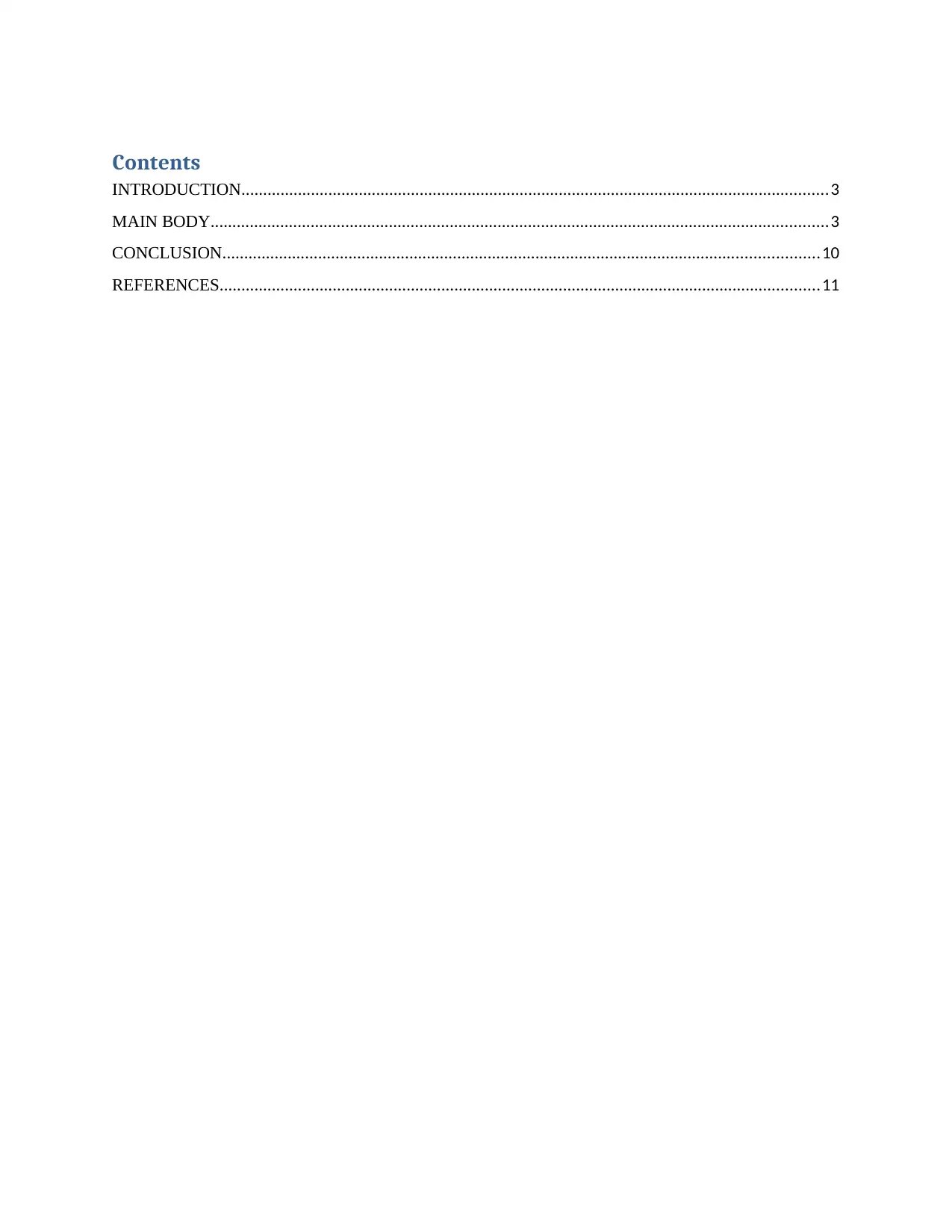
Contents
INTRODUCTION.......................................................................................................................................3
MAIN BODY..............................................................................................................................................3
CONCLUSION.........................................................................................................................................10
REFERENCES..........................................................................................................................................11
INTRODUCTION.......................................................................................................................................3
MAIN BODY..............................................................................................................................................3
CONCLUSION.........................................................................................................................................10
REFERENCES..........................................................................................................................................11
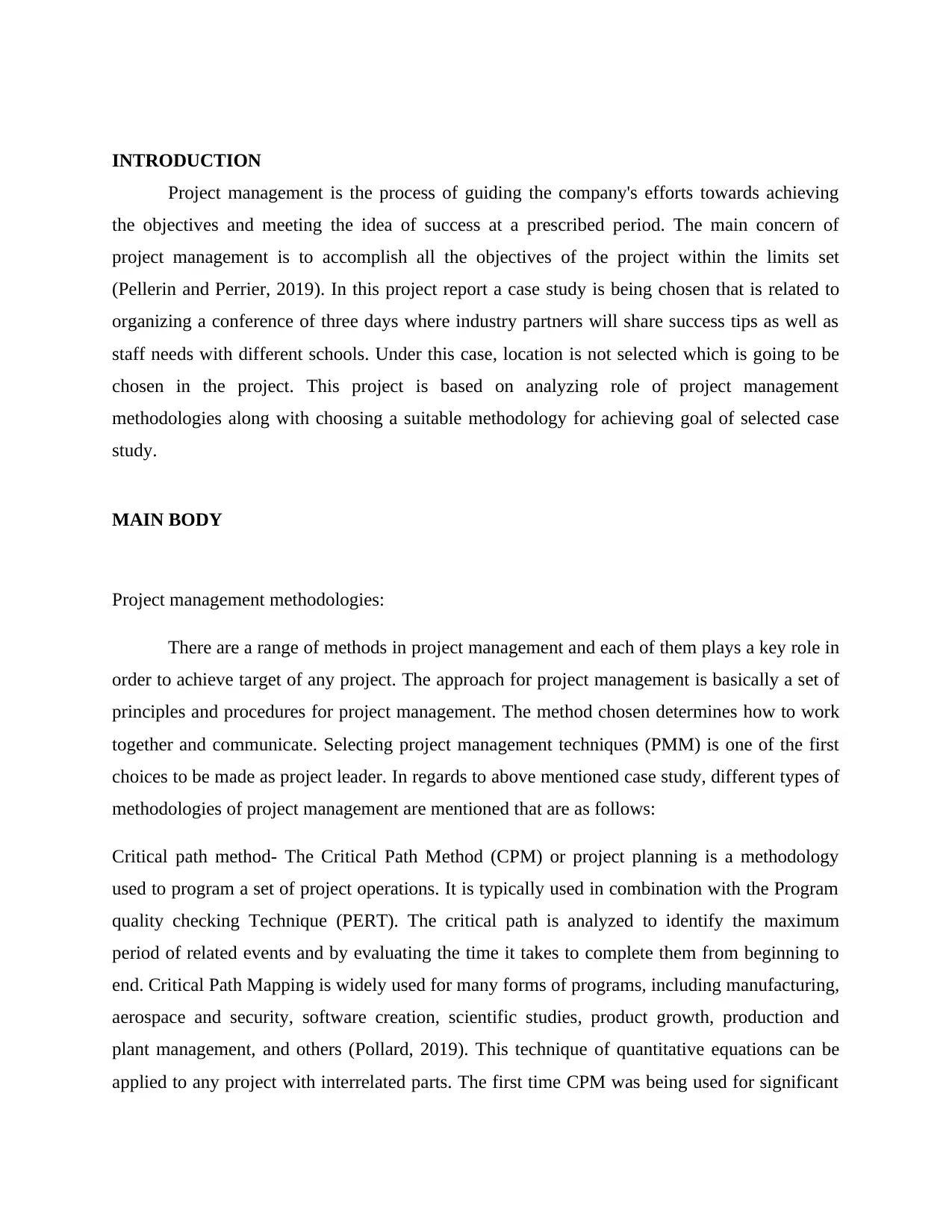
INTRODUCTION
Project management is the process of guiding the company's efforts towards achieving
the objectives and meeting the idea of success at a prescribed period. The main concern of
project management is to accomplish all the objectives of the project within the limits set
(Pellerin and Perrier, 2019). In this project report a case study is being chosen that is related to
organizing a conference of three days where industry partners will share success tips as well as
staff needs with different schools. Under this case, location is not selected which is going to be
chosen in the project. This project is based on analyzing role of project management
methodologies along with choosing a suitable methodology for achieving goal of selected case
study.
MAIN BODY
Project management methodologies:
There are a range of methods in project management and each of them plays a key role in
order to achieve target of any project. The approach for project management is basically a set of
principles and procedures for project management. The method chosen determines how to work
together and communicate. Selecting project management techniques (PMM) is one of the first
choices to be made as project leader. In regards to above mentioned case study, different types of
methodologies of project management are mentioned that are as follows:
Critical path method- The Critical Path Method (CPM) or project planning is a methodology
used to program a set of project operations. It is typically used in combination with the Program
quality checking Technique (PERT). The critical path is analyzed to identify the maximum
period of related events and by evaluating the time it takes to complete them from beginning to
end. Critical Path Mapping is widely used for many forms of programs, including manufacturing,
aerospace and security, software creation, scientific studies, product growth, production and
plant management, and others (Pollard, 2019). This technique of quantitative equations can be
applied to any project with interrelated parts. The first time CPM was being used for significant
Project management is the process of guiding the company's efforts towards achieving
the objectives and meeting the idea of success at a prescribed period. The main concern of
project management is to accomplish all the objectives of the project within the limits set
(Pellerin and Perrier, 2019). In this project report a case study is being chosen that is related to
organizing a conference of three days where industry partners will share success tips as well as
staff needs with different schools. Under this case, location is not selected which is going to be
chosen in the project. This project is based on analyzing role of project management
methodologies along with choosing a suitable methodology for achieving goal of selected case
study.
MAIN BODY
Project management methodologies:
There are a range of methods in project management and each of them plays a key role in
order to achieve target of any project. The approach for project management is basically a set of
principles and procedures for project management. The method chosen determines how to work
together and communicate. Selecting project management techniques (PMM) is one of the first
choices to be made as project leader. In regards to above mentioned case study, different types of
methodologies of project management are mentioned that are as follows:
Critical path method- The Critical Path Method (CPM) or project planning is a methodology
used to program a set of project operations. It is typically used in combination with the Program
quality checking Technique (PERT). The critical path is analyzed to identify the maximum
period of related events and by evaluating the time it takes to complete them from beginning to
end. Critical Path Mapping is widely used for many forms of programs, including manufacturing,
aerospace and security, software creation, scientific studies, product growth, production and
plant management, and others (Pollard, 2019). This technique of quantitative equations can be
applied to any project with interrelated parts. The first time CPM was being used for significant
⊘ This is a preview!⊘
Do you want full access?
Subscribe today to unlock all pages.

Trusted by 1+ million students worldwide
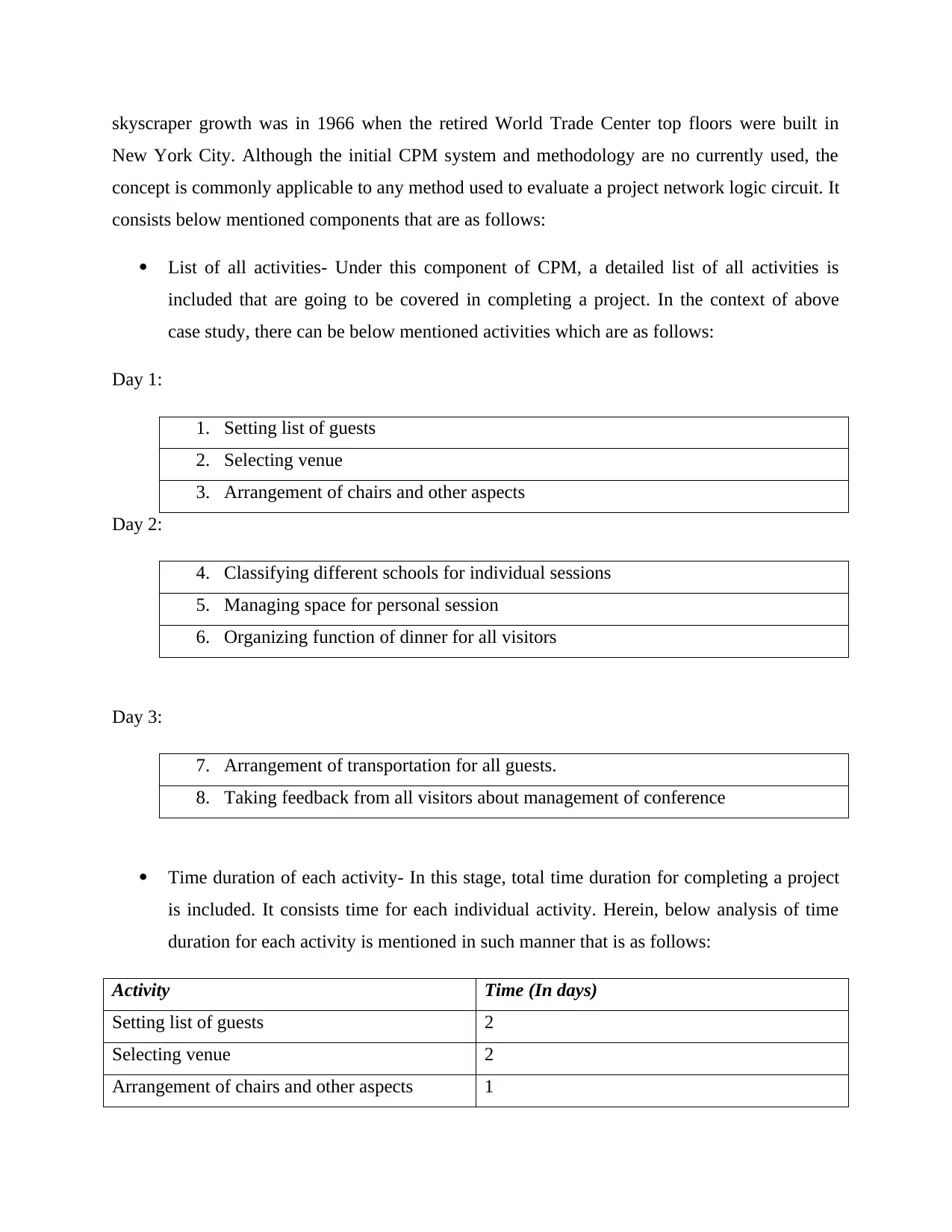
skyscraper growth was in 1966 when the retired World Trade Center top floors were built in
New York City. Although the initial CPM system and methodology are no currently used, the
concept is commonly applicable to any method used to evaluate a project network logic circuit. It
consists below mentioned components that are as follows:
List of all activities- Under this component of CPM, a detailed list of all activities is
included that are going to be covered in completing a project. In the context of above
case study, there can be below mentioned activities which are as follows:
Day 1:
1. Setting list of guests
2. Selecting venue
3. Arrangement of chairs and other aspects
Day 2:
4. Classifying different schools for individual sessions
5. Managing space for personal session
6. Organizing function of dinner for all visitors
Day 3:
7. Arrangement of transportation for all guests.
8. Taking feedback from all visitors about management of conference
Time duration of each activity- In this stage, total time duration for completing a project
is included. It consists time for each individual activity. Herein, below analysis of time
duration for each activity is mentioned in such manner that is as follows:
Activity Time (In days)
Setting list of guests 2
Selecting venue 2
Arrangement of chairs and other aspects 1
New York City. Although the initial CPM system and methodology are no currently used, the
concept is commonly applicable to any method used to evaluate a project network logic circuit. It
consists below mentioned components that are as follows:
List of all activities- Under this component of CPM, a detailed list of all activities is
included that are going to be covered in completing a project. In the context of above
case study, there can be below mentioned activities which are as follows:
Day 1:
1. Setting list of guests
2. Selecting venue
3. Arrangement of chairs and other aspects
Day 2:
4. Classifying different schools for individual sessions
5. Managing space for personal session
6. Organizing function of dinner for all visitors
Day 3:
7. Arrangement of transportation for all guests.
8. Taking feedback from all visitors about management of conference
Time duration of each activity- In this stage, total time duration for completing a project
is included. It consists time for each individual activity. Herein, below analysis of time
duration for each activity is mentioned in such manner that is as follows:
Activity Time (In days)
Setting list of guests 2
Selecting venue 2
Arrangement of chairs and other aspects 1
Paraphrase This Document
Need a fresh take? Get an instant paraphrase of this document with our AI Paraphraser
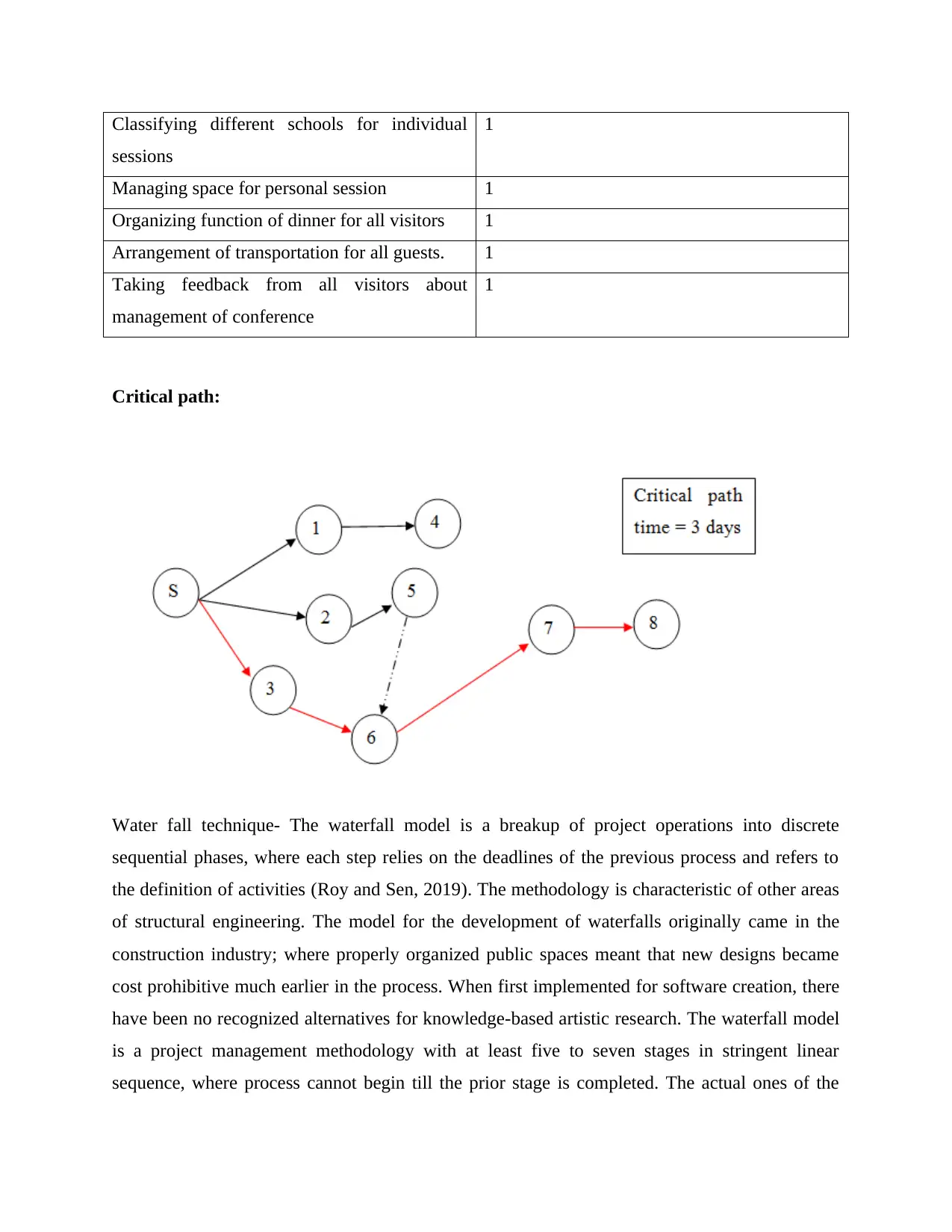
Classifying different schools for individual
sessions
1
Managing space for personal session 1
Organizing function of dinner for all visitors 1
Arrangement of transportation for all guests. 1
Taking feedback from all visitors about
management of conference
1
Critical path:
Water fall technique- The waterfall model is a breakup of project operations into discrete
sequential phases, where each step relies on the deadlines of the previous process and refers to
the definition of activities (Roy and Sen, 2019). The methodology is characteristic of other areas
of structural engineering. The model for the development of waterfalls originally came in the
construction industry; where properly organized public spaces meant that new designs became
cost prohibitive much earlier in the process. When first implemented for software creation, there
have been no recognized alternatives for knowledge-based artistic research. The waterfall model
is a project management methodology with at least five to seven stages in stringent linear
sequence, where process cannot begin till the prior stage is completed. The actual ones of the
sessions
1
Managing space for personal session 1
Organizing function of dinner for all visitors 1
Arrangement of transportation for all guests. 1
Taking feedback from all visitors about
management of conference
1
Critical path:
Water fall technique- The waterfall model is a breakup of project operations into discrete
sequential phases, where each step relies on the deadlines of the previous process and refers to
the definition of activities (Roy and Sen, 2019). The methodology is characteristic of other areas
of structural engineering. The model for the development of waterfalls originally came in the
construction industry; where properly organized public spaces meant that new designs became
cost prohibitive much earlier in the process. When first implemented for software creation, there
have been no recognized alternatives for knowledge-based artistic research. The waterfall model
is a project management methodology with at least five to seven stages in stringent linear
sequence, where process cannot begin till the prior stage is completed. The actual ones of the
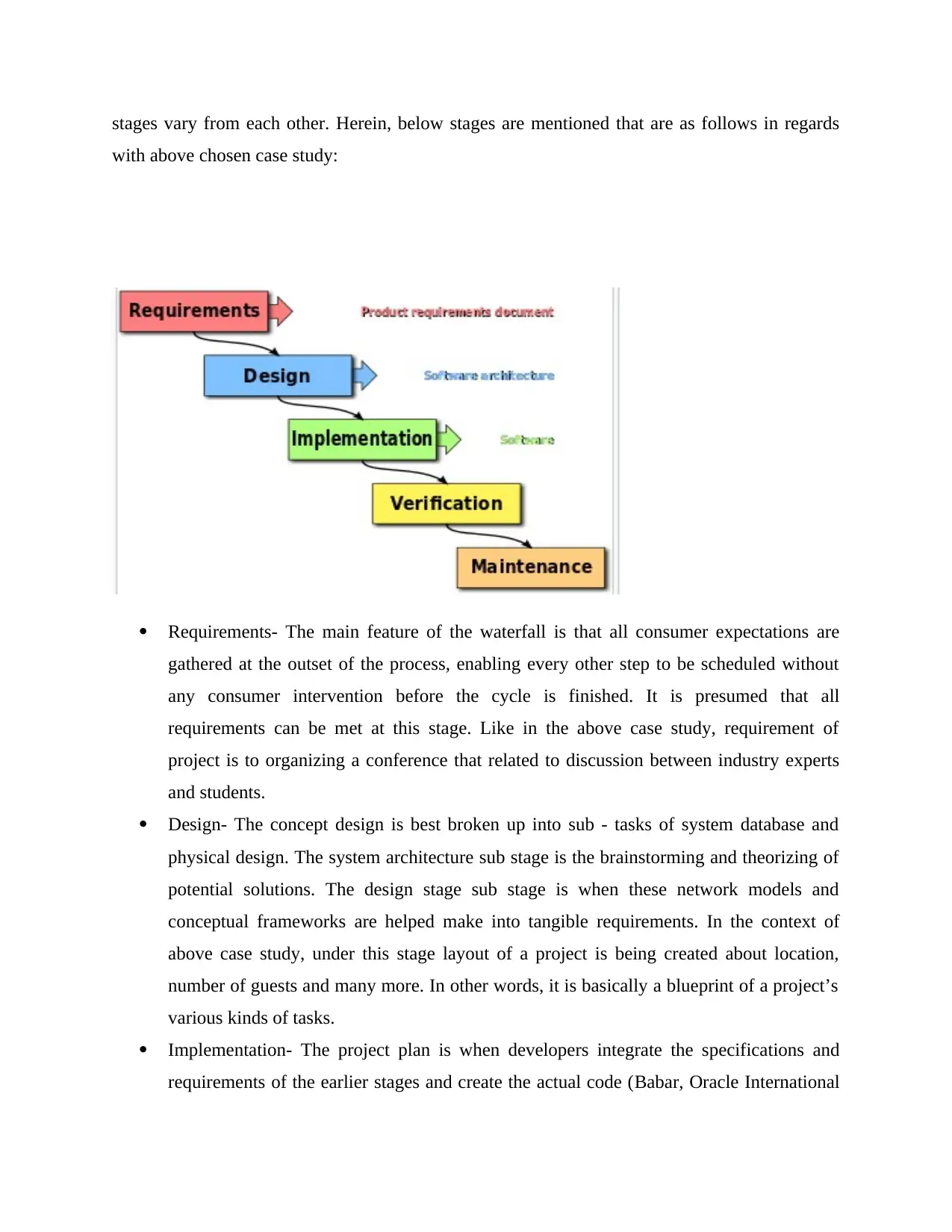
stages vary from each other. Herein, below stages are mentioned that are as follows in regards
with above chosen case study:
Requirements- The main feature of the waterfall is that all consumer expectations are
gathered at the outset of the process, enabling every other step to be scheduled without
any consumer intervention before the cycle is finished. It is presumed that all
requirements can be met at this stage. Like in the above case study, requirement of
project is to organizing a conference that related to discussion between industry experts
and students.
Design- The concept design is best broken up into sub - tasks of system database and
physical design. The system architecture sub stage is the brainstorming and theorizing of
potential solutions. The design stage sub stage is when these network models and
conceptual frameworks are helped make into tangible requirements. In the context of
above case study, under this stage layout of a project is being created about location,
number of guests and many more. In other words, it is basically a blueprint of a project’s
various kinds of tasks.
Implementation- The project plan is when developers integrate the specifications and
requirements of the earlier stages and create the actual code (Babar, Oracle International
with above chosen case study:
Requirements- The main feature of the waterfall is that all consumer expectations are
gathered at the outset of the process, enabling every other step to be scheduled without
any consumer intervention before the cycle is finished. It is presumed that all
requirements can be met at this stage. Like in the above case study, requirement of
project is to organizing a conference that related to discussion between industry experts
and students.
Design- The concept design is best broken up into sub - tasks of system database and
physical design. The system architecture sub stage is the brainstorming and theorizing of
potential solutions. The design stage sub stage is when these network models and
conceptual frameworks are helped make into tangible requirements. In the context of
above case study, under this stage layout of a project is being created about location,
number of guests and many more. In other words, it is basically a blueprint of a project’s
various kinds of tasks.
Implementation- The project plan is when developers integrate the specifications and
requirements of the earlier stages and create the actual code (Babar, Oracle International
⊘ This is a preview!⊘
Do you want full access?
Subscribe today to unlock all pages.

Trusted by 1+ million students worldwide

Corp, 2019). In the context of above company’s project, this stage can be applied if all
tasks and activities are being prepared. This stage is just like testing of all preparation
done regards to project.
Verification- This process is when the consumer reviews the brand to verify that it
complies the criteria set out at the start of the project. This is executed by having to
release the finished service to the market. In regards with above case study’s project this
stage can be applied by taking review of all visitors who will come in the conference.
Maintenance- The user utilizes the service periodically during the repair process, finding
glitches, lack of functionality and other mistakes that have arisen during development.
The development department shall implement such corrections when appropriate before
the consumer is pleased. In context of above case study, this stage can be applied after
taking review form visitors who attends the conference. Such as if any visitor demands
for any additional service then this stage can be applied in order to make modification in
existing policy or strategies.
Critical chain method- The Critical Chain Method is a technique that changes the project
timeline to address for scarce funds by attaching length outputs which are non-work plan tasks to
remain focused on the length of scheduled events (Poston and Richardson, 2019). Critical Chain
Project Management (CCPM) is a type of project preparation and management that stresses the
tools (people, facilities, physical space) needed to accomplish the work of the organization.
These were designed by Eliyahu M. Goldratt. It varies from more conventional methods derived
from main path and PERT methodologies that illustrate start point and stiff planning. The
Critical Chain Project system strives to preserve funds at a level, requiring them to be adaptable
at kickoff time. In regards to above case study’s project this technique can be applied in such
manner that is follows:
Development of task list as per critical path method- In this stage, a complete task list is
prepared in accordance of previous mentioned technique of project management
(Pellerin, Perrier and Berthaut, 2020). In regards with above company’s case study, their
task list can be prepared in accordance of above mentioned list of task of three different
days.
tasks and activities are being prepared. This stage is just like testing of all preparation
done regards to project.
Verification- This process is when the consumer reviews the brand to verify that it
complies the criteria set out at the start of the project. This is executed by having to
release the finished service to the market. In regards with above case study’s project this
stage can be applied by taking review of all visitors who will come in the conference.
Maintenance- The user utilizes the service periodically during the repair process, finding
glitches, lack of functionality and other mistakes that have arisen during development.
The development department shall implement such corrections when appropriate before
the consumer is pleased. In context of above case study, this stage can be applied after
taking review form visitors who attends the conference. Such as if any visitor demands
for any additional service then this stage can be applied in order to make modification in
existing policy or strategies.
Critical chain method- The Critical Chain Method is a technique that changes the project
timeline to address for scarce funds by attaching length outputs which are non-work plan tasks to
remain focused on the length of scheduled events (Poston and Richardson, 2019). Critical Chain
Project Management (CCPM) is a type of project preparation and management that stresses the
tools (people, facilities, physical space) needed to accomplish the work of the organization.
These were designed by Eliyahu M. Goldratt. It varies from more conventional methods derived
from main path and PERT methodologies that illustrate start point and stiff planning. The
Critical Chain Project system strives to preserve funds at a level, requiring them to be adaptable
at kickoff time. In regards to above case study’s project this technique can be applied in such
manner that is follows:
Development of task list as per critical path method- In this stage, a complete task list is
prepared in accordance of previous mentioned technique of project management
(Pellerin, Perrier and Berthaut, 2020). In regards with above company’s case study, their
task list can be prepared in accordance of above mentioned list of task of three different
days.
Paraphrase This Document
Need a fresh take? Get an instant paraphrase of this document with our AI Paraphraser

Estimating task duration at 50 % level- In this stage, time duration of each activity and
tasks is determined at the possibility of 50% of success. Herein, below time duration of
each activity is mentioned in such manner:
Activity Time (In days)
Setting list of guests 1
Selecting venue 1
Arrangement of chairs and other aspects 0.5
Classifying different schools for individual
sessions
0.5
Managing space for personal session 0.5
Organizing function of dinner for all visitors 0.5
Arrangement of transportation for all guests. 0.5
Taking feedback from all visitors about
management of conference
0.5
Estimating task duration at 95 % level- In this stage, time duration of each activity and
tasks is determined at the possibility of 95% of success. Herein, below time duration of
each activity is mentioned in such manner:
Activity Time (In days)
Setting list of guests 1.9
Selecting venue 1.9
Arrangement of chairs and other aspects 0.95
Classifying different schools for individual
sessions
0.95
Managing space for personal session 0.95
Organizing function of dinner for all visitors 0.95
Arrangement of transportation for all guests. 0.95
Taking feedback from all visitors about
management of conference
0.95
tasks is determined at the possibility of 50% of success. Herein, below time duration of
each activity is mentioned in such manner:
Activity Time (In days)
Setting list of guests 1
Selecting venue 1
Arrangement of chairs and other aspects 0.5
Classifying different schools for individual
sessions
0.5
Managing space for personal session 0.5
Organizing function of dinner for all visitors 0.5
Arrangement of transportation for all guests. 0.5
Taking feedback from all visitors about
management of conference
0.5
Estimating task duration at 95 % level- In this stage, time duration of each activity and
tasks is determined at the possibility of 95% of success. Herein, below time duration of
each activity is mentioned in such manner:
Activity Time (In days)
Setting list of guests 1.9
Selecting venue 1.9
Arrangement of chairs and other aspects 0.95
Classifying different schools for individual
sessions
0.95
Managing space for personal session 0.95
Organizing function of dinner for all visitors 0.95
Arrangement of transportation for all guests. 0.95
Taking feedback from all visitors about
management of conference
0.95
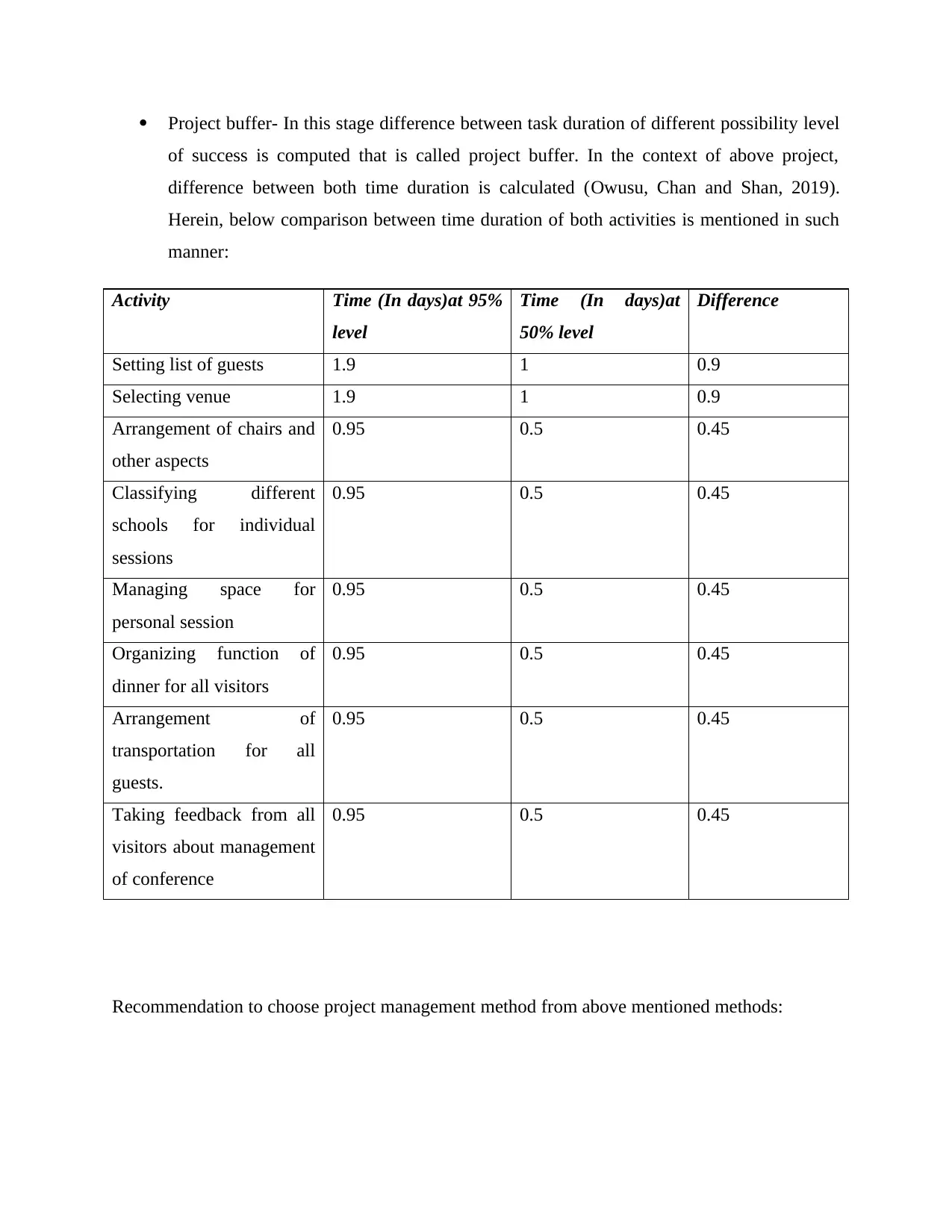
Project buffer- In this stage difference between task duration of different possibility level
of success is computed that is called project buffer. In the context of above project,
difference between both time duration is calculated (Owusu, Chan and Shan, 2019).
Herein, below comparison between time duration of both activities is mentioned in such
manner:
Activity Time (In days)at 95%
level
Time (In days)at
50% level
Difference
Setting list of guests 1.9 1 0.9
Selecting venue 1.9 1 0.9
Arrangement of chairs and
other aspects
0.95 0.5 0.45
Classifying different
schools for individual
sessions
0.95 0.5 0.45
Managing space for
personal session
0.95 0.5 0.45
Organizing function of
dinner for all visitors
0.95 0.5 0.45
Arrangement of
transportation for all
guests.
0.95 0.5 0.45
Taking feedback from all
visitors about management
of conference
0.95 0.5 0.45
Recommendation to choose project management method from above mentioned methods:
of success is computed that is called project buffer. In the context of above project,
difference between both time duration is calculated (Owusu, Chan and Shan, 2019).
Herein, below comparison between time duration of both activities is mentioned in such
manner:
Activity Time (In days)at 95%
level
Time (In days)at
50% level
Difference
Setting list of guests 1.9 1 0.9
Selecting venue 1.9 1 0.9
Arrangement of chairs and
other aspects
0.95 0.5 0.45
Classifying different
schools for individual
sessions
0.95 0.5 0.45
Managing space for
personal session
0.95 0.5 0.45
Organizing function of
dinner for all visitors
0.95 0.5 0.45
Arrangement of
transportation for all
guests.
0.95 0.5 0.45
Taking feedback from all
visitors about management
of conference
0.95 0.5 0.45
Recommendation to choose project management method from above mentioned methods:
⊘ This is a preview!⊘
Do you want full access?
Subscribe today to unlock all pages.

Trusted by 1+ million students worldwide
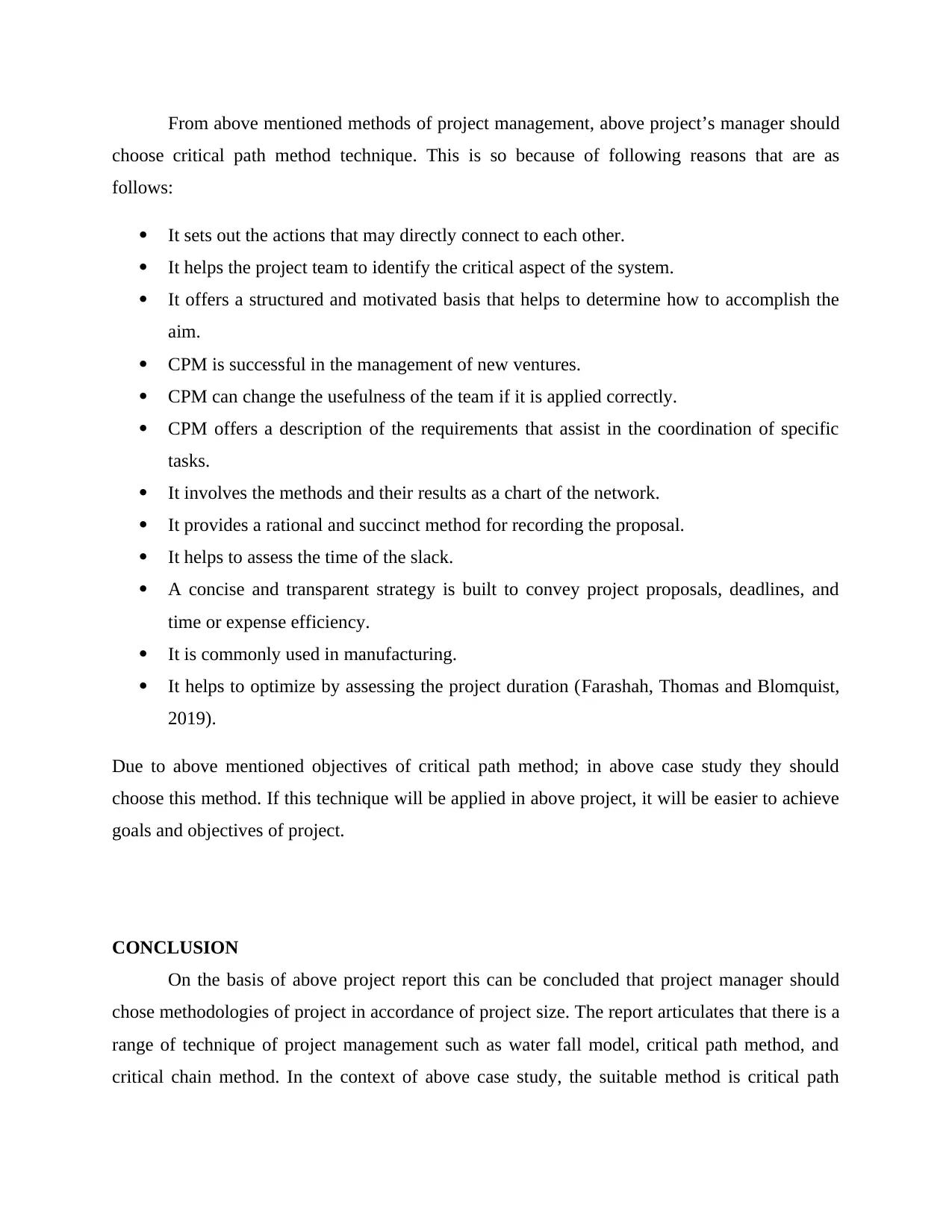
From above mentioned methods of project management, above project’s manager should
choose critical path method technique. This is so because of following reasons that are as
follows:
It sets out the actions that may directly connect to each other.
It helps the project team to identify the critical aspect of the system.
It offers a structured and motivated basis that helps to determine how to accomplish the
aim.
CPM is successful in the management of new ventures.
CPM can change the usefulness of the team if it is applied correctly.
CPM offers a description of the requirements that assist in the coordination of specific
tasks.
It involves the methods and their results as a chart of the network.
It provides a rational and succinct method for recording the proposal.
It helps to assess the time of the slack.
A concise and transparent strategy is built to convey project proposals, deadlines, and
time or expense efficiency.
It is commonly used in manufacturing.
It helps to optimize by assessing the project duration (Farashah, Thomas and Blomquist,
2019).
Due to above mentioned objectives of critical path method; in above case study they should
choose this method. If this technique will be applied in above project, it will be easier to achieve
goals and objectives of project.
CONCLUSION
On the basis of above project report this can be concluded that project manager should
chose methodologies of project in accordance of project size. The report articulates that there is a
range of technique of project management such as water fall model, critical path method, and
critical chain method. In the context of above case study, the suitable method is critical path
choose critical path method technique. This is so because of following reasons that are as
follows:
It sets out the actions that may directly connect to each other.
It helps the project team to identify the critical aspect of the system.
It offers a structured and motivated basis that helps to determine how to accomplish the
aim.
CPM is successful in the management of new ventures.
CPM can change the usefulness of the team if it is applied correctly.
CPM offers a description of the requirements that assist in the coordination of specific
tasks.
It involves the methods and their results as a chart of the network.
It provides a rational and succinct method for recording the proposal.
It helps to assess the time of the slack.
A concise and transparent strategy is built to convey project proposals, deadlines, and
time or expense efficiency.
It is commonly used in manufacturing.
It helps to optimize by assessing the project duration (Farashah, Thomas and Blomquist,
2019).
Due to above mentioned objectives of critical path method; in above case study they should
choose this method. If this technique will be applied in above project, it will be easier to achieve
goals and objectives of project.
CONCLUSION
On the basis of above project report this can be concluded that project manager should
chose methodologies of project in accordance of project size. The report articulates that there is a
range of technique of project management such as water fall model, critical path method, and
critical chain method. In the context of above case study, the suitable method is critical path
Paraphrase This Document
Need a fresh take? Get an instant paraphrase of this document with our AI Paraphraser

method. It is so because this technique is too beneficial among all methods of project
management.
management.
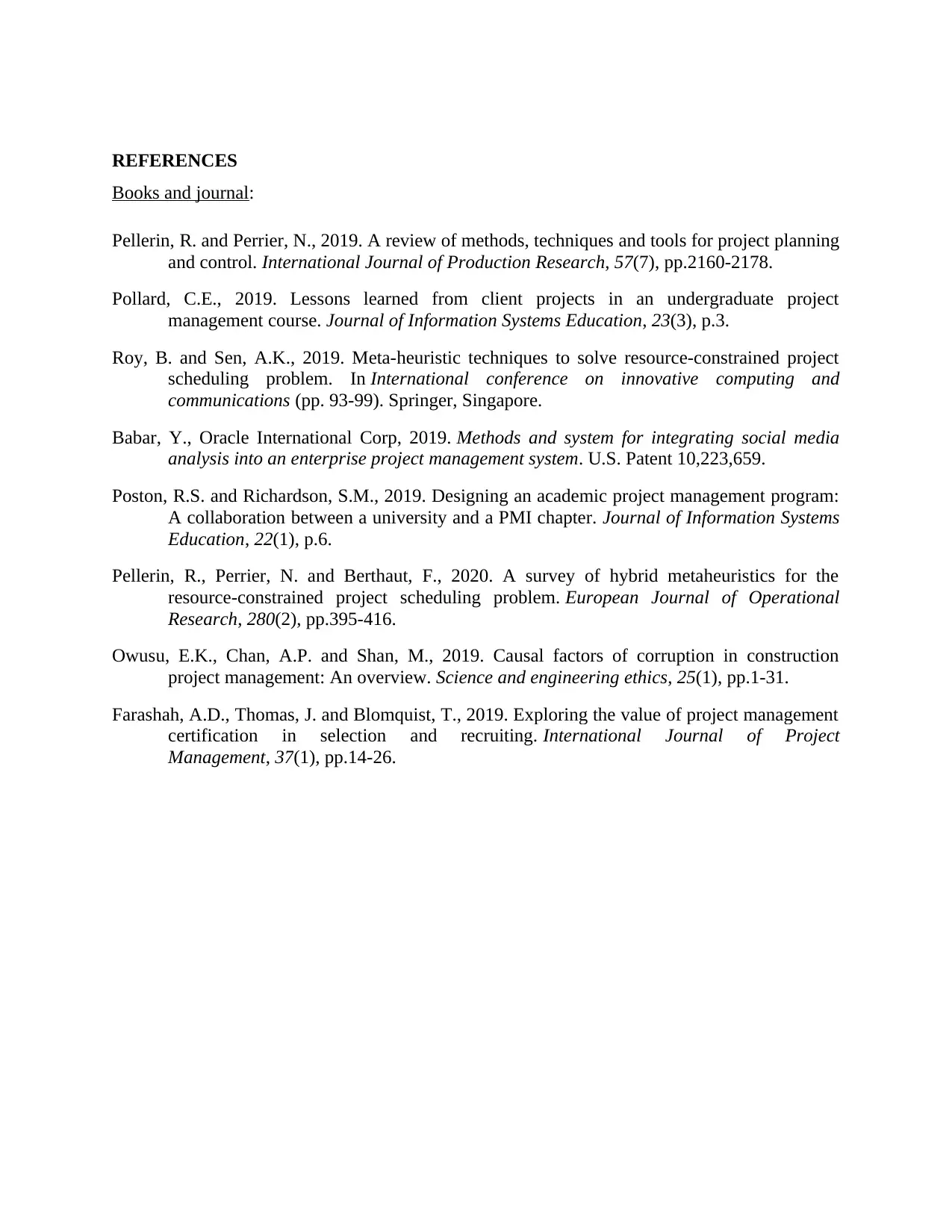
REFERENCES
Books and journal:
Pellerin, R. and Perrier, N., 2019. A review of methods, techniques and tools for project planning
and control. International Journal of Production Research, 57(7), pp.2160-2178.
Pollard, C.E., 2019. Lessons learned from client projects in an undergraduate project
management course. Journal of Information Systems Education, 23(3), p.3.
Roy, B. and Sen, A.K., 2019. Meta-heuristic techniques to solve resource-constrained project
scheduling problem. In International conference on innovative computing and
communications (pp. 93-99). Springer, Singapore.
Babar, Y., Oracle International Corp, 2019. Methods and system for integrating social media
analysis into an enterprise project management system. U.S. Patent 10,223,659.
Poston, R.S. and Richardson, S.M., 2019. Designing an academic project management program:
A collaboration between a university and a PMI chapter. Journal of Information Systems
Education, 22(1), p.6.
Pellerin, R., Perrier, N. and Berthaut, F., 2020. A survey of hybrid metaheuristics for the
resource-constrained project scheduling problem. European Journal of Operational
Research, 280(2), pp.395-416.
Owusu, E.K., Chan, A.P. and Shan, M., 2019. Causal factors of corruption in construction
project management: An overview. Science and engineering ethics, 25(1), pp.1-31.
Farashah, A.D., Thomas, J. and Blomquist, T., 2019. Exploring the value of project management
certification in selection and recruiting. International Journal of Project
Management, 37(1), pp.14-26.
Books and journal:
Pellerin, R. and Perrier, N., 2019. A review of methods, techniques and tools for project planning
and control. International Journal of Production Research, 57(7), pp.2160-2178.
Pollard, C.E., 2019. Lessons learned from client projects in an undergraduate project
management course. Journal of Information Systems Education, 23(3), p.3.
Roy, B. and Sen, A.K., 2019. Meta-heuristic techniques to solve resource-constrained project
scheduling problem. In International conference on innovative computing and
communications (pp. 93-99). Springer, Singapore.
Babar, Y., Oracle International Corp, 2019. Methods and system for integrating social media
analysis into an enterprise project management system. U.S. Patent 10,223,659.
Poston, R.S. and Richardson, S.M., 2019. Designing an academic project management program:
A collaboration between a university and a PMI chapter. Journal of Information Systems
Education, 22(1), p.6.
Pellerin, R., Perrier, N. and Berthaut, F., 2020. A survey of hybrid metaheuristics for the
resource-constrained project scheduling problem. European Journal of Operational
Research, 280(2), pp.395-416.
Owusu, E.K., Chan, A.P. and Shan, M., 2019. Causal factors of corruption in construction
project management: An overview. Science and engineering ethics, 25(1), pp.1-31.
Farashah, A.D., Thomas, J. and Blomquist, T., 2019. Exploring the value of project management
certification in selection and recruiting. International Journal of Project
Management, 37(1), pp.14-26.
⊘ This is a preview!⊘
Do you want full access?
Subscribe today to unlock all pages.

Trusted by 1+ million students worldwide
1 out of 12
Related Documents
Your All-in-One AI-Powered Toolkit for Academic Success.
+13062052269
info@desklib.com
Available 24*7 on WhatsApp / Email
![[object Object]](/_next/static/media/star-bottom.7253800d.svg)
Unlock your academic potential
Copyright © 2020–2025 A2Z Services. All Rights Reserved. Developed and managed by ZUCOL.




